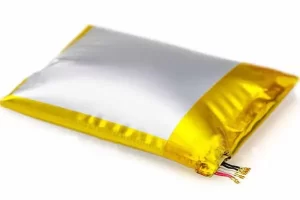
Lithium battery swelling, is, commonly known as bulging. It often results from internal chemical reactions, leading to gas buildup, which causes the battery to expand and distort.
The swelling process can compromise the battery’s integrity, potentially leading to leaks, fires, or even explosions. Safely disposing of these batteries is crucial to prevent environmental harm and personal injury.
Part 1. Why do lithium batteries swell?

Lithium polymer batteries are swelling and bulging with the quality of lithium batteries, the use of methods, the environment, and many other factors. We concluded the number of reasons as follows:
Poor packaging: air moisture enters the inside of the battery cell during the production process, causing the electrolyte to analyze the appearance of gas.
The water content of the electric core exceeds the standard: in the process, once the water content exceeds the standard, the electrolyte will fail to appear gas.
Corrosion: Lithium polymer cell corrosion occurs, the aluminum layer is consumed by the reaction, losing the use of the water barrier, and flatulence occurs.
Surface breakage: damaged by external forces, puncture leads to water into the interior of the battery core. In addition, the chemical properties of lithium materials are too active, which poses an extremely high risk. When lithium metal is exposed to air, it will have a violent oxidation reaction with oxygen.
Impact: Aluminum material is easily deformed and gently knocked, the larger the core, the larger the air pocket, the easier it is to damage.
Short circuit: positive and negative contacts lead to short circuits, lithium polymer battery cells bulging, or even smoke.
Internal short circuit: shrinkage, curling, breakage of the battery isolation film, burrs piercing the isolation film, etc. can cause internal disconnection and thus bulging.
Over-charging/over-discharging: Polymer batteries are over-charged or over-discharged, and coupled with abnormalities in the protection board, the battery cells will experience serious bulging.
Part 2. How do you dispose of lipo batteries?
Isolation and safety measures
When handling swollen lithium polymer (LiPo) batteries, isolation and safety measures are paramount. These batteries can pose severe risks due to potential leaks, fires, or explosions.
Isolation
Begin by isolating the swollen battery in a safe, controlled environment to minimize the risk of accidents. Always wear appropriate protective gear, such as gloves and eye protection, to prevent direct contact with any leaked chemicals or substances.
Safety measures
Ensure the area is well-ventilated and free from any flammable materials or sources of ignition. Any handling of swollen batteries should be done cautiously and with great care.
Transportation and storage
Transporting a swollen LiPo battery demands extreme caution to avoid accidents during transit. Use a fireproof container that can contain potential fires or leaks from the damaged battery. Store the container in a cool, dry place away from direct sunlight and sources of heat.
Handling precautions
Avoid storing multiple swollen batteries together as this could increase the risk of accidents. Always handle and transport such batteries individually.
Recycling programs
Utilizing dedicated battery recycling programs or facilities that accept damaged lithium batteries is a safe and responsible disposal method. Many recycling centers have the expertise and resources to handle damaged batteries safely and to prevent environmental contamination.
Collection centers
Locate recycling centers that specifically cater to damaged or swollen LiPo batteries. These centers often have specialized equipment and procedures to handle and dispose of damaged batteries in an environmentally friendly manner.
Part 3. Lipo battery disposal DIY guidelines
Puncturing and discharging
Disposing of swollen lithium polymer (LiPo) batteries can be a challenging task. However, if you’re knowledgeable and cautious, there are DIY methods to handle this safely.
Puncturing
Puncturing the battery is a risky method but can be employed by knowledgeable individuals. Use a non-conductive tool to puncture the battery in a controlled environment with proper safety gear. This should be done in an area that’s fireproof and isolated from combustible materials.
Discharging
After puncturing, discharge the battery slowly in a safe manner to reduce the risk of ignition or combustion. A bucket of saltwater or sand can be used to immerse the battery to dampen any potential fire hazards.
Neutralizing chemicals
When dealing with damaged LiPo batteries, there might be leaked or exposed chemicals. Neutralize any spilled electrolyte by carefully applying baking soda or another alkaline substance. This can help neutralize the acidic properties of the electrolyte, reducing its potential harm.
Precautions
Always handle any spilled chemicals with extreme caution. Wear appropriate protective gear such as gloves and goggles to prevent direct contact.
Container disposal
Once the battery is discharged and neutralized, place it in a fireproof container. A metal container with a tight-fitting lid can help contain any potential fires or leaks that might occur during storage or transportation.
Transportation
Ensure the container is stored in a cool, dry place away from direct sunlight or heat sources. If possible, transport the container to a hazardous waste disposal facility that can handle damaged or hazardous batteries.
Part 4. Conclusion
Safe disposal of swollen LiPo batteries requires a careful approach that prioritizes safety and environmental responsibility. Isolation, safe handling, proper transportation, and utilizing recycling programs are essential steps to prevent accidents, environmental contamination, and personal harm. Always follow recommended guidelines and seek professional assistance if uncertain about handling damaged batteries.
Part 5. FAQs
-
What to do with a swollen lithium battery?
Safely handle swollen lithium batteries by avoiding puncturing or mishandling them. Store them in a fireproof container and seek recycling options or professional disposal services. -
How do you safely discharge a LiPo battery?
Safely discharge a LiPo battery by using a specific discharge device or discharging it through a low-power device until it reaches a safe voltage level, following proper safety precautions. -
What happens if you puncture a lithium polymer battery?
Puncturing a lithium polymer battery can cause it to short-circuit, leading to thermal runaway, overheating, or even fire. Immediately evacuate the area and seek professional help. -
How do you dispose of a ruptured lithium battery?
If a lithium battery is ruptured or damaged, handle it with extreme caution using gloves and place it in a fireproof container, then contact local waste disposal or recycling facilities for proper handling. -
Is it bad to leave a LiPo fully charged?
Leaving a LiPo battery fully charged for extended periods can increase degradation and reduce its lifespan. Storing LiPo batteries at around 50% charge is recommended for long-term storage to maintain their health.
Related Tags:
More Articles
Overview of Deep Cycle Lithium Battery
In this article, we explore the life, voltage, capacity, and charging considerations of deep cycle lithium batteries.
How Long do Lithium Batteries Last?
How long do lithium batteries last? we will explore the factors that influence the lifespan of lithium batteries and provide insights into their longevity.
How to Choose the Best LiFePO4 Battery?
Choose LiFePO4 batteries for superior performance, safety, and versatility in EVs, UPS, and backup power. This guide helps you make informed decisions.
Get 12v Lithium Car Battery As a Power Source for the Ride
Make the right choice for your vehicle's battery needs by installing a 12 volt lithium car battery. You will enjoy maintenance-free longevity with this change.


